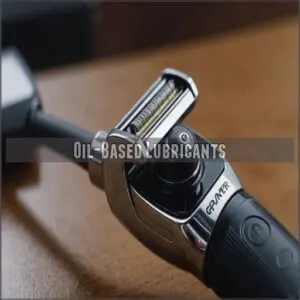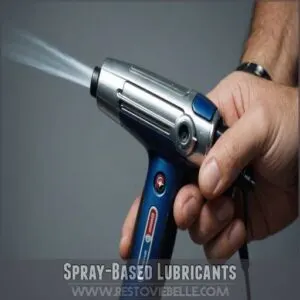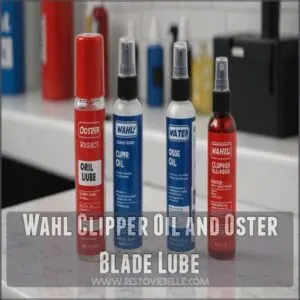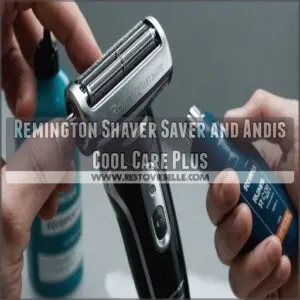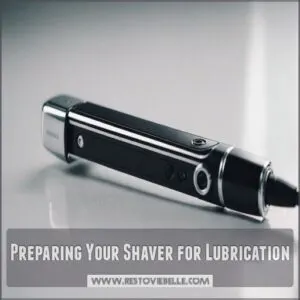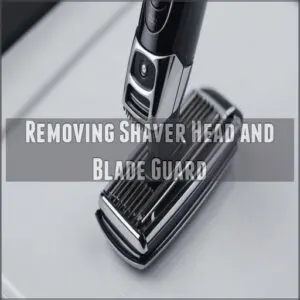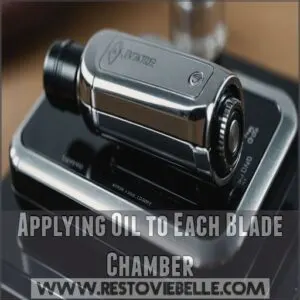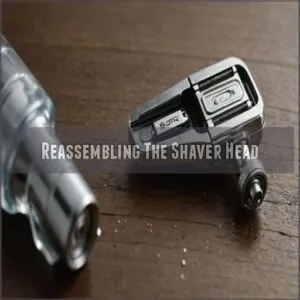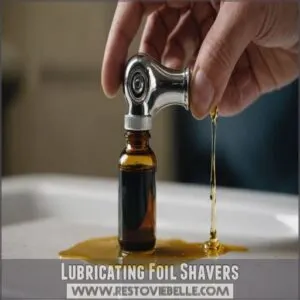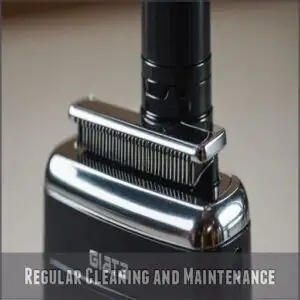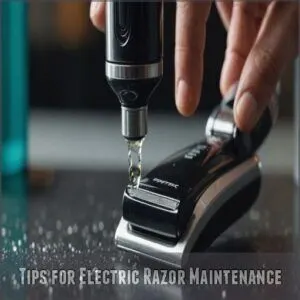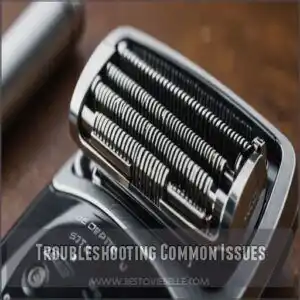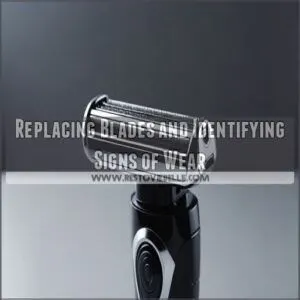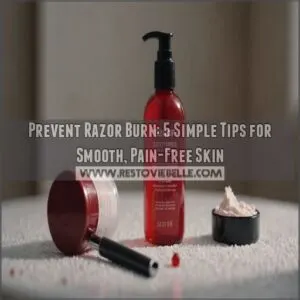This site is supported by our readers. We may earn a commission, at no cost to you, if you purchase through links.
 Oiling an electric razor is as important as feeding a hungry monster—starvation leads to trouble!
Oiling an electric razor is as important as feeding a hungry monster—starvation leads to trouble!
Start by using a light mineral oil or hair clipper oil.
For foil shavers, apply a drop on each foil and trimmer.
Got a rotary razor? Drop oil on each head.
Run the razor briefly to spread the oil evenly.
This way, you reduce heat, extend blade life, and get a smooth shave without irritating your skin.
No one likes morning surprises during a rushed routine!
Remember, a well-oiled razor keeps your shave sharp and long-lasting, like a trusty old friend.
Curious about more tips?
Table Of Contents
- Key Takeaways
- Benefits of Lubricating Electric Razors
- Choosing The Right Lubricant
- Preparing Your Shaver for Lubrication
- Lubricating Rotary Blade Shavers
- Lubricating Foil Shavers
- Lubrication Frequency and Cleaning
- Regular Cleaning and Maintenance
- Tips for Electric Razor Maintenance
- Troubleshooting Common Issues
- Replacing Blades and Identifying Signs of Wear
- Frequently Asked Questions (FAQs)
- What can I use to lubricate an electric razor?
- How do you put oil in an electric razor?
- Do electric shavers need to be oiled?
- How do you oil an electric Clipper?
- Can oil affect the shavers performance?
- Should I oil a new shaver right away?
- Are there eco-friendly shaver oils available?
- How do I store a lubricated shaver?
- Does oiling void the shavers warranty?
- Conclusion
Key Takeaways
- Use a light mineral oil or hair clipper oil on foils and blades to reduce friction and extend their lifespan. Regular maintenance, such as sharpening your clippers with a handheld sharpener or electric sharpener using proper sharpening techniques, also helps to maintain your razor’s performance and longevity.
- Apply just a drop of oil to each head for rotary razors, ensuring even distribution by running the razor briefly after oiling.
- Clean your shaver regularly to prevent build-up, and ensure it is completely dry before oiling to avoid damage.
- Oiling your electric razor improves motor efficiency, reduces heat, and minimizes skin irritation and blemishes.
Benefits of Lubricating Electric Razors
You’ll be surprised how much smoother your shave gets when you start using the right techniques as outlined in electric razor shaving techniques, oiling your electric razor regularly.
It reduces heat and friction, but it also extends the life of your blades and leaves your skin happier—like a win-win for your face and wallet.
Reduces Heat and Friction
Imagine this: a smooth glide with your shaver, where blades stay cool and there’s none of that annoying irritation.
Lubricating your razor makes it happen, reducing heat and friction with each shave.
This fine-tuning doesn’t just improve your shave quality; it boosts the overall performance.
You’ll get a cooler shave, less irritation, and a shave that just feels right.
Prolongs Life of Blades and Foils
Keeping your electric razor oiled is particularly important for those with sensitive skin, as it can help reduce irritation when using a foil shaver for sensitive skin. Keeping your electric razor oiled helps prolong blade longevity and foil lifespan.
Think of it as your razor’s fountain of youth, which is especially important when cleaning an electric razor.
Here’s how it helps:
- Reduces friction, making the blades glide smoothly.
- Minimizes wear and tear, cutting down replacement costs.
- Maintains efficiency, so your razor’s always ready to deliver.
Improves Shave Quality
When you oil your electric razor, it feels like butter.
Blade sharpness is key for a close shave; without it, you risk razor burn and skin irritation.
A smooth glide boosts shave quality, making the entire experience as sleek as your freshly shaved face.
Here’s how oil improves:
| Benefit | Impact | Result |
|---|---|---|
| Blade sharpness | Enhanced longevity | Smoother shave |
| Smooth glide | Less friction | Comfort |
| Close shave | Precise cutting | Clean finish |
Minimizes Irritation and Blemishes
Because a well-oiled razor glides smoothly, you’ll experience less tugging and pulling.
This prevents razor burn, ingrown hairs, and those pesky little blemishes.
You can find a range of specialized electric shaver oils to keep your razor running smoothly.
Proper lubrication is key for sensitive skin.
Think of it as a mini spa treatment for your face!
Regular oiling keeps your shave comfortable and your skin happy.
It’s a simple shaving technique that makes a big difference in your skin care routine.
Improves Motor Efficiency
Boosting your razor’s motor efficiency isn’t just a tech trick—it’s like greasing a squeaky hinge. This reduces motor noise and extends motor lifespan.
Want to keep it purring? Watch for:
- Oil type impact: Use the right lubricant.
- Over-oiling risks: A little goes a long way.
- Cleaning routine: Keeps things smooth.
- Motor noise: Silence says it all.
Choosing The Right Lubricant
When choosing a lubricant for your electric razor, you’ll want to stick to oils specifically designed for the job, like clipper oil or baby oil.
Avoid kitchen concoctions like coconut or olive oil; your razor isn’t planning a salad dressing anytime soon!
Oil-Based Lubricants
To keep your electric razor purring like a kitten, reach for oil-based lubricants.
Think of these as the secret sauce that cuts down on friction and extends blade life.
Clipper oil is excellent, offering the right viscosity for smooth shaving.
Just a drop or two, applied regularly, will keep your razor in tip-top shape.
Spray-Based Lubricants
Spray-based lubricants are like a magic mist for your electric razor.
They’re quick, easy, and less messy than oils.
Just spritz, and you’re ready to go!
Remember to hold the can about four inches away to avoid flooding.
Sprays cover evenly, ensuring each blade glides smoothly.
Store them in a cool, dry place to keep them effective.
Wahl Clipper Oil and Oster Blade Lube
Wahl Clipper Oil and Oster Blade Lube can keep your blades gliding like a hot knife through butter.
These oils are perfect for keeping your electric razor rust-free and sharp.
- Best Use Cases: Electric shavers and trimmers.
- DIY Alternatives: Baby oil works in a pinch.
- Frequency of Use: Apply weekly.
- Safety Concerns: Avoid skin contact; always unplug first.
Remington Shaver Saver and Andis Cool Care Plus
Ever wondered about Remington Shaver Saver vs. Andis Cool Care Plus?
These two are like the Batman and Robin of razor maintenance.
They help smooth operations by reducing friction.
Apply them easily—just a spritz and you’re golden.
With rave user reviews and wide product availability, mastering oil application techniques becomes a breeze.
Say goodbye to stubble struggles!
Preparing Your Shaver for Lubrication
Before you oil your electric razor, give it a good cleaning.
This means rinsing away any hair and debris, then making sure everything’s completely dry before adding lubricant—you don’t want a watery mess!
Thorough Cleaning of Shaver Head
Once you’ve picked your perfect lubricant, it’s time to get your shaver squeaky clean.
A thorough shaver head cleaning sets the stage for smooth shaving, using techniques that work well with top-rated models like best electric head shavers. A thorough shaver head cleaning sets the stage for smooth shaving.
Use a small brush or a can of compressed air to dust off any hair clippings clinging to the blades.
Remember, consistency is key—clean your shaver frequently, especially if it’s water-resistant.
Removing Debris With Water or Compressed Air
Blast away stubborn debris like a pro.
Water-resistant shavers, such as the Philips Norelco Shaver 4100 with its waterproof design, make it easy—just rinse under running water.
For a deeper clean, grab some compressed air.
It’s like a fresh start for your shaver:
- Turn it off first.
- Use short bursts.
- Keep the can upright.
- Avoid tilting.
Say goodbye to grit and grime!
Ensuring Complete Dryness Before Lubrication
You’ve rinsed away the debris, good start!
Now, to sidestep pesky water damage, make sure your shaver is completely dry.
Let it air dry naturally or use a lint-free towel to dab it gently.
This prevents sneaky lint from sneaking in.
Give it ample drying time, as moisture can sneak into nooks, messing with your razor’s mojo.
Lubricating Rotary Blade Shavers
To keep your rotary blade shaver running smoothly, start by removing the shaver head and blade guard.
Just a drop of oil in each blade chamber will have your shaver purring like a kitten, ready for a close, comfortable shave.
Removing Shaver Head and Blade Guard
Removing the shaver head and blade guard is like peeling an orange—it’s all about technique.
Twist off the head, taking care not to drop parts like fragile dreams.
Use a soft brush or canned air for cleaning any residue, and don’t forget to pick up some rotary shaver oil for your rotary blade.
Mind your tools—keep them nearby for reassembly.
Avoid forcing parts apart; finesse keeps things smooth without hiccups or headaches.
Applying Oil to Each Blade Chamber
Next up, let’s get those blade chambers slick and ready.
Grab your recommended clipper oil and apply a single drop into each rotary blade chamber.
Regularly lubricating your trimmer, like learning how to oil beard trimmer, can keep your blades cutting over 70% more effectively.
Picture it as feeding your razor’s engine, keeping it purring.
This small act helps smooth operation while extending blade life.
Remember, a little oil goes a long way—like sunscreen on a cloudy day!
Reassembling The Shaver Head
Carefully align the shaver head, ensuring proper blade placement.
Tighten the screws securely; you should hear a satisfying clicking mechanism.
Snap the head back into place—it’s like giving your shaver a hug! A little bit of force is okay; just don’t be overly aggressive.
Double-check everything is snug and ready to go.
Lubricating Foil Shavers
Oiling your foil shaver helps it glide smoothly, delivering a close, comfortable shave and keeping your skin happy.
Just a quick spritz on the foil chambers and a drop on the cutting blades does the trick, but remember to wipe off any excess—nobody wants a slippery bathroom floor!
Applying Oil to Foil Chambers
Foil shavers, like those utilizing oscillating blades under a thin foil, need regular love just like rotary ones.
Give each foil chamber a quick spritz of oil; a lightweight oil meant for clippers will do wonders.
Feel the difference:
- Prevent Friction: Keep things smooth with just a drop.
- Extend Life: Safeguard the blades’ lifespan.
- Enhance Efficiency: Boost your shaver’s performance.
Remember, less is more.
Lubricating Cutting Blades
Once you’ve oiled the foil chambers, it’s time to tackle the cutting blades.
Tilt your shaver slightly and add a drop of oil to the exposed blades.
This oiling reduces blade wear and keeps your shave smooth and irritation-free.
Just like moisturize-and-go, your shaver appreciates this little boost to perform at its best.
| Oil Types | Lubrication Frequency | Cleaning Methods |
|---|---|---|
| Clipper oil | Few times a week | Water rinse |
| Baby oil | Depends on use | Compressed air |
| Specialist | After using creams | Warm water flush |
Removing Excess Oil
Taking care of excess oil isn’t rocket science.
Use a soft cloth or tissue to gently wipe the outer shaver surface, catching any stray oil drops.
This prevents residue buildup, ensuring your shaver stays in top shape.
Think of it as giving your shaver a quick polish, making sure everything’s neat, tidy, and ready for action.
Lubrication Frequency and Cleaning
Keeping your electric razor well-lubricated helps you get a smooth shave and also extends the life of your shaver.
Clean your razor regularly, ditch the soap when possible, and sprinkle a little oil love to avoid embarrassing shaving mishaps.
No Soap Cleaning
After giving your foil shaver its lubrication love, let’s chat about no-soap cleaning.
No need for suds here! A simple water rinse keeps things fresh without hassle.
Just flick the head open, rinse it under warm water, and shake it dry.
Do this regularly to keep your maintenance schedule on point.
Remember, cleanliness boosts shave quality and preserves the shaver’s life.
Soap Cleaning
Soap cleaning’s a bit trickier. That shaving soap residue can really gum things up!
Rinse thoroughly after each shave to remove any soap buildup.
Don’t forget to dry your razor completely before storing it.
Regular cleaning, maybe once a week, keeps things running smoothly.
Cleaning frequency depends on how often you shave and what kind of shaving soap you use.
Remember, a clean razor is a happy razor!
Using Spray Lubricant With Soap Cleaning
Incorporating spray lubricant after soap cleaning helps your razor stay in top shape.
Soap residue can impact performance, so a quick spritz of lubricant helps maintain efficiency.
Use the right spray type for best results, comparing options can be enlightening.
Keep a regular cleaning frequency to enjoy a smoother shave while mastering your grooming routine with ease.
Pre-Shave Lubrication
Using oil before shaving adds a protective layer, making your shave smoother and reducing friction.
Just a drop or two will do wonders for both wet and dry shavers, especially if you’re using shaving cream.
Check out different pre-shave oil types, like almond or sandalwood oil, and consider adding this step regularly to improve your shaving game.
Regular Cleaning and Maintenance
To keep your travel-friendly electric razor in top shape, especially when relying on best travel electric razors for smooth shaving on the go, regular cleaning and maintenance are essential.
Imagine your razor transforming into a hair-obsessed vacuum if you skip the daily cleaning or forget to replace worn blades and foils.
Daily Cleaning of Shaver Head
Keep your shaver purring like a kitten with daily shaver head cleaning.
Grab a small brush or blow off hair clippings – don’t let gunk take over!
It’s like flossing for your razor.
Regular attention prevents build-up, keeps you shaving smooth, and avoids annoying cleaning mistakes.
Master this habit, and your shaver rewards you with peak performance!
Deep Cleaning of Blades and Cutting Cassette
Got a stubborn shaver head? Time to get into deep cleaning!
Disassemble it carefully, and use small brushes or compressed air as cleaning tools to remove debris.
Don’t skimp on drying techniques—moisture is a no-no.
Store your razor safely after each cleaning.
For a smooth shave, follow this frequency guide: clean monthly or when the performance dips.
Replacing Blades and Foils
Swap out those dull blades or foils to keep your shaver humming. Here’s your quick guide:
- Replacement frequency: Every 12-18 months.
- Signs of wear: Pulling hair, uneven cut.
- Cost comparison: Weigh new blades against a new razor.
- DIY vs. professional: Go DIY; it’s easy!
- Best brands: Braun, Philips, Panasonic.
Tips for Electric Razor Maintenance
Proper maintenance keeps your electric razor humming along, providing years of smooth shaves. This section offers simple tips for cleaning, oiling, and extending the life of your valuable shaving tool.
Cleaning Waterproof Razors
Water-resistant shavers are a breeze to clean.
Just rinse under running water after each use; it’s like giving your razor a mini shower.
No soap, just a splash.
Pat it dry with a towel to avoid water spots.
For best practices, let it air dry fully before storing.
Your razor will thank you by staying sharp and smooth!
Cleaning Non-Waterproof Razors
Cleaning non-waterproof razors isn’t rocket science, but don’t dunk them!
Think of them as gremlins—water’s their kryptonite.
Use a soft brush or cloth as your cleaning tools to whisk away debris.
For drying techniques, pat gently, ensuring it’s bone dry.
Keep a cleaning schedule to dodge damage, and consider these maintenance tips: no soaking, no submersion—just TLC.
Clippers and Trimmers Maintenance
Keeping your clippers and trimmers in top shape feels like coaxing a stubborn mule; it takes patience, but the payoff’s worth it.
To maximize effectiveness and longevity, consider sharpening clipper blades every few weeks for peak performance.
Try these steps:
- Blade Cleaning: Brush out hair and dirt.
- Oil Types: Use recommended oils only—clipper oil works wonders.
- Frequency: Clean and oil after each use; store them dry to avoid rust.
Regular Blade Lubrication
Imagine your razor blades as tiny dancers, gliding smoothly thanks to regular lubrication.
Apply oil a few times a week, especially if using shaving cream, to fend off blade wear.
Stick to clipper oils or specialist sprays—cooking oils aren’t invited to this party.
Keep it simple, safe, and efficient, and your shave will stay excellent.
Troubleshooting Common Issues
When your electric razor starts behaving like it’s got a mind of its own, don’t panic.
Learn how to tackle common problems like reduced shave quality, increased friction, or those pesky motor issues to keep your morning routine smooth.
Reduced Shave Quality
Spotting reduced shave quality? It might be clogged or dull blades, shaver age, or even your shaving technique playing tricks on you.
Try checking the blade sharpness—if it’s off, the shaver won’t perform well.
A bit of maintenance can work wonders.
Remember, even the best razors need a little TLC to keep you looking sharp.
Increased Heat and Friction
A dull shave often means your razor’s overheating.
Blade overheating is a common sign of insufficient lubrication.
Remember, proper lubrication is key for shaver efficiency.
Ignoring this leads to motor damage and shortens blade lifespan.
So, oil your razor regularly!
It’s a small step with big rewards – a smoother shave and a longer-lasting tool.
You’ll thank yourself later.
Blade and Foil Wear
When your electric razor starts pulling instead of cutting, it might be time to check for signs of blade wear.
Seeing frayed foils? That’s a signal for replacement.
Prolonging blade longevity saves on replacement costs but also boosts performance.
Don’t hesitate to explore DIY repair if you’re handy; it extends foil lifespan and improves your shave.
Motor Efficiency Issues
Motor efficiency isn’t just about cutting forte; it’s also about preserving your shaver’s energy.
A well-lubricated shaver reduces motor noise, improves battery life, and prevents overheating.
If you’re noticing your shave takes longer or feels warmer, it’s time for a check-up.
Regular care keeps everything running smoothly.
- Clean blades frequently
- Check lubrication weekly
- Watch for battery drainage
- Monitor shaving speed
Replacing Blades and Identifying Signs of Wear
Noticing your electric razor isn’t cutting as close or feels hotter than usual?
It might be time to replace those blades, following manufacturer guidelines, or risk your shave turning into a tug-of-war.
Signs of Wear and Tear
Your electric razor might be showing its age if you’ve noticed more hair pulling or reduced closeness in your shave.
If the blades tug or the shaver heats up like a summer sidewalk, this could be due to the effects of dull blades.
Dull blades can be caused by factors such as hair type, blade usage, and cleaning habits, as outlined in the guide on how to sharpen electric razor blades.
Keep an eye out for foil dents too.
These are all red flags that your razor’s blades are past their prime.
Manufacturer Recommendations for Replacement
Most manufacturers suggest replacing your razor’s blades and foils every 12 to 18 months to keep that shave smooth and efficient.
This timeline hinges on how often you shave; more use means quicker wear.
Look out for reduced cutting effectiveness or increased skin irritation.
With maintenance awareness, you can make sure your razor always performs at its best.
Cost Considerations for Replacement
Regarding replacement costs, it’s like choosing between budget shavers or splurging on a luxury model.
Think of it as car maintenance: you wouldn’t ignore a flat tire.
You can also find affordable electric razor blades online at websites like Electric Razor Blades Store.
Consider these tips to save:
- Explore generic brands for cost savings.
- Attempt DIY repair for minor issues.
- Track blade lifespan for timely swaps.
- Evaluate your usage to maximize efficiency.
Frequently Asked Questions (FAQs)
What can I use to lubricate an electric razor?
Use clipper oil, baby oil, or specialized sprays to lubricate your electric razor.
Avoid cooking oils and motor oil.
These alternatives reduce friction, maintain blade performance, and extend the lifespan of your shaver.
Keep it smooth!
How do you put oil in an electric razor?
To oil your electric razor, apply a drop of clipper oil to each blade chamber and turn it on for a few seconds.
This helps blades glide smoothly, reducing friction and extending razor life.
Do electric shavers need to be oiled?
Think of oiling your electric shaver as giving it a revitalizing spa day.
Yes, these gadgets need lubrication to glide smoothly, reduce friction, and prevent overheating.
Keep them pampered to guarantee a close, comfy shave.
How do you oil an electric Clipper?
Start by cleaning your clipper.
Add a drop of clipper oil to the blades while holding it at a 45-degree angle.
Turn it on for a few seconds, letting the oil spread evenly, and wipe excess.
Can oil affect the shavers performance?
Improper oil can gum up your razor’s works, dulling blades and even harming the motor.
Use the right oil—a drop or spritz will do—for a smooth, long-lasting shave.
Don’t overdo it!
Should I oil a new shaver right away?
Why rush into it?
It’s best to wait before oiling your new shaver until after initial use and cleaning.
This helps maintain its efficiency by ensuring only necessary lubrication is applied, avoiding any excess build-up.
Are there eco-friendly shaver oils available?
Yes, there are eco-friendly oils for your shaver.
Look for natural oils like jojoba or almond oil.
They’re biodegradable and gentle on your skin while keeping your shaver in top shape without harming the planet.
How do I store a lubricated shaver?
Treat your shaver like a prized sports car; store it in a cool, dry place after lubricating, standing upright if possible.
Use a soft cloth to cover it, keeping dust at bay and ensuring it’s ready to roll.
Does oiling void the shavers warranty?
Oiling usually doesn’t void your shaver’s warranty, but it’s important to check the manufacturer’s guidelines first.
They often recommend using specific oils.
Using the wrong type might lead to issues, and nobody wants that hassle.
Conclusion
Picture a well-oiled machine that glides effortlessly—that’s your goal with an electric razor.
By knowing how to oil an electric razor, you’re not just maintaining a tool; you’re ensuring a consistently smooth shave and prolonging its lifespan.
Regular lubrication keeps the blades sharp and your skin happy, avoiding the irritation and wear that come from neglect.
Keep your razor in top form, save time, and enjoy every shave.
Your face will thank you for the care.


